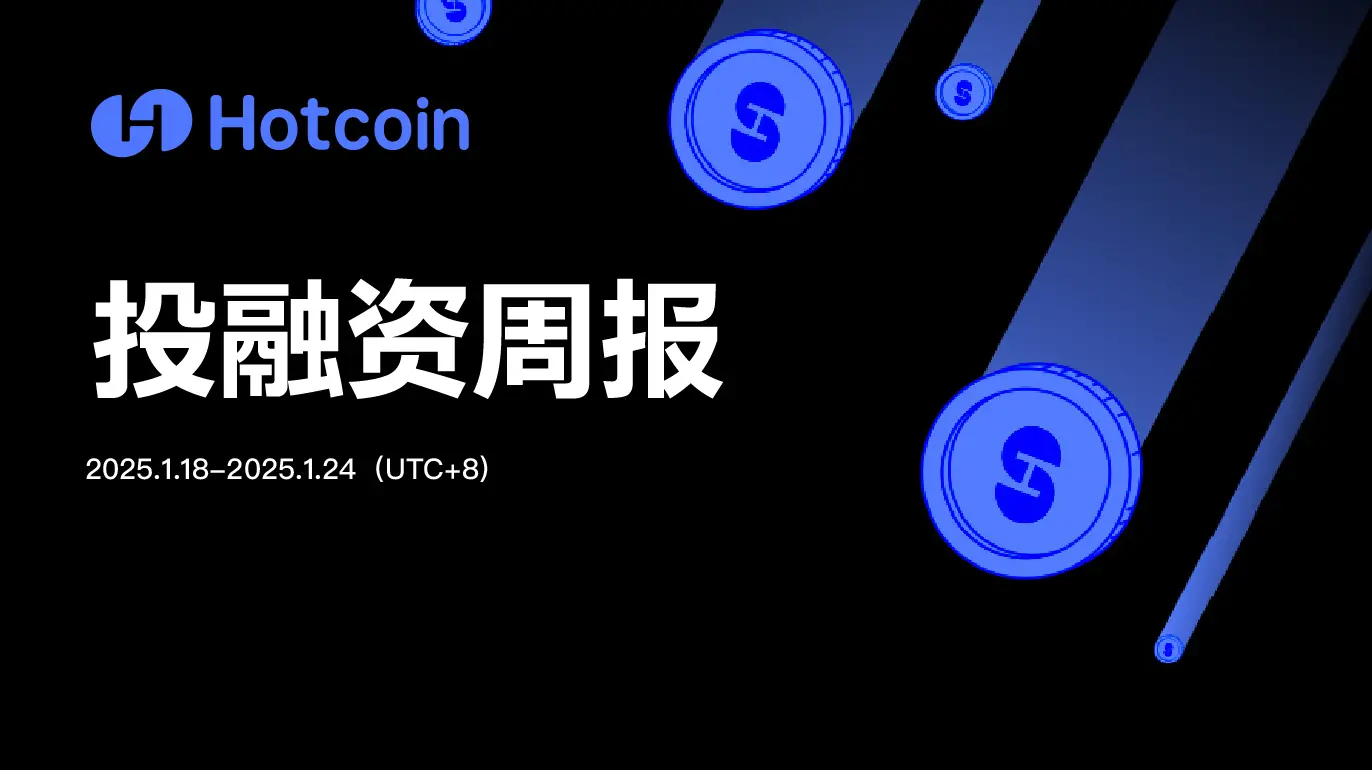Hotcoin Research: A Comprehensive Analysis of the EigenLayer Ecosystem: The Prelude to Re-staking and the Rise of AVS
The re-staking protocol EigenLayer, based on the Ethereum network, proposes to utilize ETH staked for validating the Ethereum network to share security and capital efficiency with other protocols, while providing additional interest to protocol participants. Driven by concepts such as AVS, re-staking, and point systems, a large ecosystem has gradually formed. From early 2024 to now, EigenLayer's TVL has increased 12-fold, attracting approximately $160 million in investments from crypto VCs including a16z, rapidly rising to the second position in the total TVL ranking of DeFi protocols, second only to Lido. Recently, with the launch of the EigenLayer mainnet, it has sparked industry discussions and widespread attention.
1. Overview of EigenLayer
EigenLayer is a re-staking protocol based on Ethereum that allows ETH already staked on the Ethereum network to enhance network security through re-staking. In other words, users who stake ETH can choose to join EigenLayer smart contracts to re-stake their ETH and extend the cryptoeconomic security to other applications on the network. At the same time, it will provide additional returns for network participants. This process not only improves capital utilization efficiency but also enhances the overall security of the network.
EigenLayer supports the secure operation of other blockchain protocols and applications by leveraging ETH already staked on Ethereum, a process known as re-staking. Re-staking allows Ethereum validators to use part or all of their staked ETH to support other Active Validation Services (AVS), such as bridging protocols, sequencers, and oracles. These services typically require their own staking and validation mechanisms to ensure network security, but through EigenLayer's re-staking feature, they can obtain Ethereum-level security without having to attract large amounts of capital themselves.
Through re-staking, originally single-purpose staked capital can simultaneously support multiple networks, thereby enhancing the capital efficiency and security of the entire ecosystem. This mechanism does not require additional native tokens; it only needs to use ETH or liquid staking tokens (LST), such as stETH, rETH, etc., to participate in the staking validation process of AVS.
The features and advantages of EigenLayer are as follows:
Establishing a new security-sharing model: The innovation of EigenLayer lies in bringing a new model of security sharing to Ethereum, allowing different blockchain protocols to share Ethereum's security infrastructure without having to build a large network of validation nodes themselves, significantly reducing the startup costs for new blockchain protocols. Additionally, re-staking increases the network's resistance to attacks, as attacking any protected protocol requires overcoming the security protections added by re-staking.
Enhancing ETH capital efficiency: The re-staking mechanism introduced by EigenLayer improves the liquidity and utilization efficiency of capital. Now, the same ETH can serve multiple networks simultaneously, allowing users to enjoy the original staking rewards while also earning additional rewards for participating in other AVS protocols. This brings greater flexibility and scalability to the Ethereum network and the entire blockchain ecosystem.
Lowering participation thresholds: Through the re-staking mechanism, small stakers can also participate in the security of the Ethereum network. Stakers do not need to have the complete staking threshold of 32 ETH; individual stakers can participate through liquid staking tokens (Liquidity Staking Tokens, LST). EigenLayer supports LSTs, such as stETH, which represent staking rights to the original ETH and can circulate and be used freely in DeFi projects.
Increasing decentralization: By allowing small stakes, EigenLayer further decentralizes the contributor base for network security, reducing reliance on large stakers, which helps prevent potential centralization risks and validator monopolies. Moreover, the design of EigenLayer encourages broader community participation and governance, making the blockchain network more democratic and decentralized.
2. Design Principles of EigenLayer
Re-staking: In the EigenLayer ecosystem, re-staking provides security guarantees shared with Ethereum, which is the foundation of the entire EigenLayer. Participants re-stake their ETH on Ethereum to the EigenLayer network, and this ETH serves as collateral to support the security and operation of the network. Stakers will receive dual rewards from native Ethereum network validation and AVS.
Active Validation Services (AVS): Active Validation Services (AVS) utilize these re-staked ETH to enhance their service capabilities. AVS is a special service or application that runs on EigenLayer and directly uses these re-staked funds to provide enhanced network services. These services can include various functions such as computation, storage, and data processing. AVS can be likened to middleware or modules, such as new blockchains, DA layers, virtual machines, oracle networks, cross-chain bridges, etc. AVS can provide data services for DeFi, gaming, and wallets.
Rollups: In the EigenLayer ecosystem, Rollups, as a Layer 2 solution for Ethereum, benefit from the modular services provided by AVS. For example, through services like EigenDA (EigenLayer's super data availability service), Rollups can achieve super-scalability in data processing, greatly increasing their capacity to handle large-scale data.
Operators: Operators play a key role in the EigenLayer ecosystem, executing various validation tasks that rely on staked ETH as security, which is also the foundation for AVS. The responsibilities of operators include but are not limited to validating transactions, executing smart contracts, and maintaining network security. Their work ensures that AVS can operate reliably, providing support for upper-layer applications and services.
Safeguards: Considering the additional risks that re-staking may bring, EigenLayer has introduced multiple risk control mechanisms. For example, to address potential security issues caused by AVS, EigenLayer has designed a system called "Decentralized Validator Cluster" (DVC) to disperse risks, ensuring that even if some AVS encounter problems, the overall security of the network will not be affected. To ensure the normal operation of the network and the safety of staked capital, EigenLayer implements a slashing mechanism for improperly acting stakers. Slashing refers to the method EigenLayer uses to ensure the honesty of AVS operators; validators who act maliciously will face the risk of having their stakes revoked.
Point System: EigenLayer introduces an internal point system that grants EigenLayer points for each ETH re-staked every hour. The purpose of this system is to measure users' contributions to the network, reflecting their staking activity and duration through the number of points. Although the EigenLayer team has not yet specified the exact use of points or announced any details about launching EigenLayer tokens, many users continue to engage in re-staking activities, anticipating potential future token airdrops based on points. This indicates that users hold expectations and confidence in EigenLayer's future development.
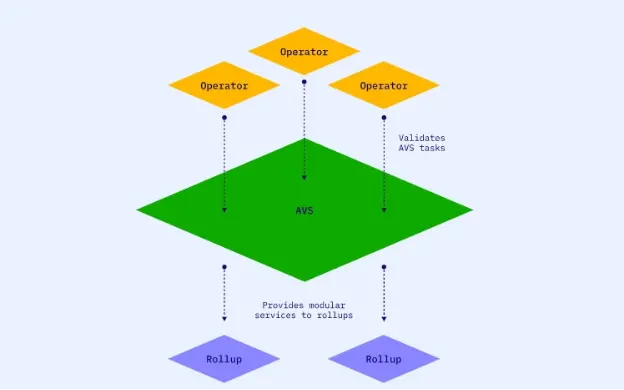
3. EigenLayer Re-staking Methods
Currently, EigenLayer supports two re-staking methods: Liquid Restaking and Native Restaking.
1. Liquid Restaking
This allows staking of liquid staking tokens (LST), which are staking certificates issued by LSP (Liquid Staking Protocol) that represent rights to the original ETH stake and can circulate and be used freely in various decentralized finance (DeFi) protocols, without affecting the staker's staking status and reward collection on Ethereum. LSP addresses certain limitations of staking on the Ethereum network, allowing users to participate in Ethereum network validation and earn validation rewards with less than 32 ETH of capital. It also allows LST to generate additional income in DeFi protocols or to be sold on the market without waiting for the unstaking period, effectively providing the same benefits as unstaked assets. For example, Lido Finance is currently the most well-known LSP, and the LST issued by Lido Finance is stETH. EigenLayer accepts users staking stETH, making it the infrastructure that secures AVS.
Currently, EigenLayer supports a total of 12 types of LST for liquid re-staking, including stETH, swETH, mETH, stETH, wbETH, rETH, sfrxETH, cbETH, osETH, oETH, lsETH, and ankrETH.
EigenLayer only accepts LST re-staking deposits during specific time periods or limits the incentives and governance participation rights obtained from a single LST from EigenLayer to a maximum of 33%. So far, EigenLayer's LST re-staking restrictions have been increased five times. On April 16, EigenLayer announced the removal of all deposit limits for LST and reopened the deposit window, allowing ETH to be re-staked through the EigenPod on the EigenLayer app.
2. Native Restaking
Native Restaking is a more direct method where stakers use their staked ETH directly in EigenLayer's smart contracts, meaning Ethereum PoS node validators connect their staked ETH in the network to EigenLayer to participate in the validation process of AVS. Executing native re-staking requires staking at least 32 ETH, and participants need to directly manage an Ethereum node, which provides a higher entry barrier compared to liquid re-staking.
Since ETH is directly used in EigenLayer's smart contracts, native re-staking offers higher security. Staked assets are directly exposed to Ethereum and AVS's penalty standards, increasing capital protection. Compared to liquid re-staking, native re-staking does not involve any intermediate tokens, reducing risks arising from token volatility or mismanagement. However, its downside is lower liquidity of funds, and unlocking and transferring assets may take longer.
4. Current Status and Project Overview of the EigenLayer Ecosystem
The EigenLayer ecosystem has begun to support various AVS and has integrated with several well-known DeFi protocols and other blockchain services. It allows the use of different types of staking proofs (such as LST and native ETH) to support these services, thereby utilizing capital more effectively.
On April 10, EigenLayer announced the official launch of its blockchain mainnet, accompanied by the launch of EigenDA, a data availability (DA) service developed by the EigenLayer team. At the end of February, a16z announced a $100 million investment in EigenLayer, making it a crypto unicorn valued at $10 billion. As of April 18, according to DefiLlama data, EigenLayer's TVL has exceeded $12.8 billion.

As of April 18, EigenLayer has distributed approximately 4.2 billion points to all re-stakers. In the over-the-counter trading market Whales Market, the trading price for each EigenLayer point is $0.165.
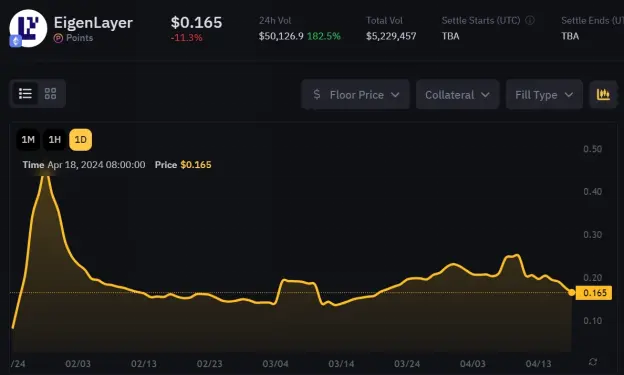
(1) Overview of EigenLayer Ecosystem AVS Projects
Currently, there are 13 AVS projects announced by EigenLayer. EigenDA, as the first launched AVS, is developed by Eigen Labs and aims to help other blockchain protocols store transaction data and other information. AVS outside of EigenDA will be able to "register" using the protocol, but they are currently not fully deployed.
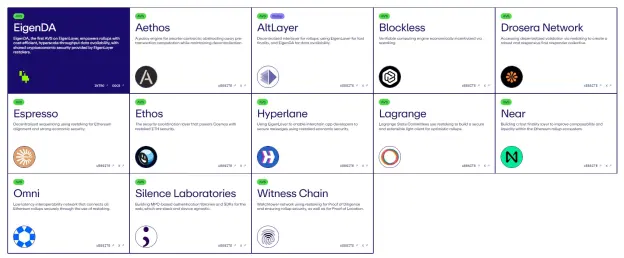
EigenDA: EigenDA is the first AVS on EigenLayer, providing efficient, super-scalable data availability services for Rollups. By leveraging the shared cryptoeconomic security provided by EigenLayer's re-stakers, EigenDA allows Rollups to process large-scale data at lower costs and higher efficiency. On April 18, EigenLayer announced that it has lowered the staking threshold for EigenDA verification nodes from 320 ETH to 96 ETH. EigenLayer stated that this change will allow more new verification nodes to participate in EigenDA's AVS verification services.
Aethos: Aethos is a policy engine for smart contracts that abstracts pre-trade computation while maintaining decentralization. Aethos simplifies the preprocessing of smart contracts, making contract execution more efficient and secure.
AltLayer: AltLayer is a decentralized inter-layer network designed for Rollups. It utilizes EigenLayer to achieve rapid finality and guarantees data availability through EigenDA, optimizing interoperability and performance between Rollups.
Blockless: Blockless is a verifiable computing engine that provides economic incentives through the re-staking mechanism. It offers a decentralized validation platform for complex computations, enhancing the transparency and credibility of computation results.
Drosera Network: Drosera Network creates a powerful and responsive first responder collective through re-staking, focusing on decentralized validation. This provides a new way for the network to offer emergency response and secure validation.
Espresso: Espresso is a decentralized serialization service that uses re-staking to achieve alignment and strong economic security for Ethereum. It ensures the order and consistency of transaction execution.
Ethos: Ethos is a secure coordination layer that leverages the security of re-staked ETH to support Cosmos. It enhances the security and efficiency of cross-chain interactions.
Hyperlane: Hyperlane uses EigenLayer to enhance message security for inter-chain application developers, providing guarantees for communication between applications through re-staked economic security.
Lagrange: Lagrange creates a secure and scalable light client through re-staking, specifically for OP Rollups. It improves network accessibility and responsiveness through light clients.
Near: Near aims to build a fast finality layer to improve composability and liquidity within the Ethereum Rollup ecosystem. This helps enhance the efficiency of cross-Rollup operations.
Omni: Omni is a low-latency interoperability network that connects all Ethereum Rollups through re-staking, ensuring the security and efficient operation of the entire network.
Silence Laboratories: Silence Laboratories is building a verification library and SDK based on multi-party computation (MPC), which are technology stack and device agnostic, enhancing the security and flexibility of the network.
Witness Chain: Witness Chain is a monitoring network that utilizes re-staking for proof, focusing on the security and proof location of Rollups. By providing proof diligence and location capabilities, it enhances the monitoring and validation capabilities of the network.
(2) Overview of EigenLayer Ecosystem Rollups Projects
Rollups projects utilize EigenLayer's technology to achieve rapid finality and efficient data availability, further expanding their blockchain solutions. Currently, there are 9 integrated Layer 2 solutions, among which AltLayer is both an AVS and a Rollup project.
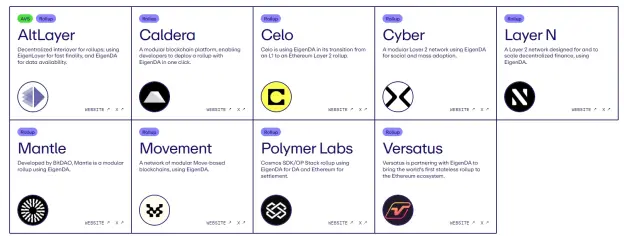
Caldera: Caldera is a modular blockchain platform that allows developers to deploy Rollups with EigenDA services with one click. This platform greatly reduces the technical barriers for developers by simplifying the deployment process, enabling more innovations and applications to go live quickly.
Celo: Celo was originally an independent layer network, and is now transitioning to a Layer 2 Rollup on Ethereum using EigenDA. Through this transformation, Celo can better integrate into the Ethereum ecosystem while enhancing its network performance and scalability.
Cyber: Cyber is a modular Layer 2 network designed for social and mass adoption, using EigenDA to optimize data processing and user experience. Cyber aims to promote the application of blockchain technology in the social media field through efficient data services.
Layer N: Layer N is a Layer 2 network designed to accelerate decentralized finance (DeFi), also employing EigenDA to enhance data processing capabilities. Through this technical support, Layer N aims to provide higher efficiency and better scalability for DeFi applications.
Mantle: Mantle, developed by BitDAO, is a modular Rollup that uses EigenDA. This project combines BitDAO's resources with EigenDA's technology to provide users with an efficient and powerful blockchain platform.
Movement: The Movement network consists of a series of modular blockchains based on the Move language, also utilizing EigenDA technology. This design allows Movement to ensure efficient data processing and security while providing flexibility.
Polymer Labs: Polymer Labs is a Rollup that combines Cosmos SDK and OP stack, using EigenDA for data availability services and settling on Ethereum. This multi-technology integration solution provides users with diverse application scenarios and strong network support.
Versatus: Versatus is a project in collaboration with EigenDA, aiming to introduce the world's first stateless Rollup into the Ethereum ecosystem. This innovative Rollup design brings new development potential to the Ethereum ecosystem through efficient data processing and a unique network structure.
(3) Overview of EigenLayer Ecosystem LRP Related Projects
The Liquid Restaking Protocol (LRP) is a key component of the EigenLayer ecosystem, designed to attract and increase user participation in a flexible and efficient manner. LRP allows users to deposit ETH or LST (liquid staking tokens) and represents users in re-staking on EigenLayer, providing users with a more flexible way to participate in the EigenLayer ecosystem. Users can choose to re-stake through the LRP platform without directly engaging in complex staking processes, including earning EigenLayer points and additional points provided by the platform.
To prove users' deposits and participation, LRP issues LRT, which represents users' staking shares in LRP. LRT serves not only as proof of the holder's assets but can also be freely traded in DeFi markets, providing additional liquidity and yield opportunities, thereby further increasing returns based on EigenLayer points. Representative LRT-related projects include Ether.fi, Kelp DAO, EigenPie, Pendle Finance, and Gearbox.
Ether.fi: As a member of the EigenLayer ecosystem, Ether.fi initially started as part of an LSP but quickly showcased its application breadth in DeFi through its innovative eETH and weETH tokens. These two tokens, through buyback mechanisms and reward nature designs, not only ensure compatibility with mainstream DeFi protocols but also enhance user participation and liquidity of staked assets through EigenLayer point farming.
Kelp DAO: Kelp DAO provides users with an attractive staking and re-staking scenario through its unique re-staking solution and Kelp Miles point system. Its development reflects the efforts of the LRP ecosystem to improve user experience and reduce transaction costs, especially in situations where high gas fees and network congestion often hinder user experience.
EigenPie: As part of the MagPie ecosystem, EigenPie focuses on aggregating governance tokens and influencing DeFi protocol decisions. Its strategy is to diversify risks and optimize the liquidity and usability of tokens through independent re-staking methods, which is crucial for promoting the long-term sustainability of the protocol.
Pendle Finance: Pendle Finance collaborates with Ether.fi to launch Ether.fi’s eETH as the first LRT available on its platform. Ether.fi has designed a system to allocate EigenLayer points and Ether.fi loyalty points to users holding eETH YT tokens (YT-eETH). This allows users to purchase YT-eETH close to expiration (which becomes cheaper) and accumulate interest and points up to that date.
Gearbox: Gearbox is a leveraged yield protocol where borrowers leverage their positions by depositing staked assets and assets borrowed from the protocol in credit accounts. Gearbox has launched a leveraged point strategy in collaboration with the LRP protocol. Gearbox allows the accumulation of EigenLayer points and LRP local points in credit accounts, sending them to borrowers' wallets, providing users with up to 9 times leveraged points.
5. Risks and Challenges of the EigenLayer Ecosystem
As a re-staking layer built on Ethereum, EigenLayer offers innovative solutions for blockchain technology but also comes with several risks and challenges.
Technical Implementation Risks: The implementation of EigenLayer heavily relies on complex technical solutions, including the stability and security of smart contracts. Vulnerabilities in smart contracts or security issues at the protocol level could lead to significant financial losses. Additionally, since EigenLayer is directly integrated with Ethereum's node ecosystem, any imperfections in technical execution could affect its overall security and efficiency.
Market Acceptance: Despite EigenLayer providing an innovative re-staking solution, market acceptance remains an important uncertainty. The volatility of the crypto market may affect the value of staked assets, and the degree to which the market embraces this emerging technology will directly impact EigenLayer's liquidity and widespread application.
Centralization Risks: The re-staking model may lead to capital concentration among a few high-performing validators, potentially exacerbating centralization trends and creating market monopolies, thus threatening the decentralization principles of the Ethereum ecosystem.
Potential for Consensus Splits: If the operational model of EigenLayer directly intervenes in Ethereum's node ecosystem, it may impact Ethereum's social consensus. If not handled properly, it could lead to community splits or even chain forks.
Risks of AVS: EigenLayer provides additional functionalities and services through its AVS (Active Validation Services), but the security and efficiency of these services depend on the reliability of operators and technical implementation. Any operational failures could result in losses for staked ETH. For AVS that require very high network security, re-staking may not provide sufficient protection, potentially affecting the trust and adoption of these services.
6. Development Outlook for the EigenLayer Ecosystem
EigenLayer has gradually evolved from the concept of sharing Ethereum network security and generating additional income into a large ecosystem that meets the needs of infrastructure builders and investors, sparking immense interest and high expectations in the infrastructure industry and crypto market.
Expansion of AVS: Following the launch of EigenDA, EigenLayer will introduce more AVS, providing more customized services, such as enhanced data processing capabilities and more efficient transaction validation, thereby expanding its service scope and influence.
Enhanced Security: By implementing advanced security measures and audit mechanisms such as slashing, EigenLayer ensures that the operation of AVS is not affected by malicious attacks or vulnerabilities.
Cross-chain Integration: Developing cross-chain solutions that allow EigenLayer to serve not only Ethereum but also interoperate with other major blockchains, enhancing its market applicability and user base. Collaborating with more blockchains and crypto projects to achieve technical interoperability and improve overall network efficiency.
Ecosystem Expansion: Establishing partnerships with more ecosystem projects such as DeFi, DAOs, and NFT platforms, bringing value to these platforms through efficient re-staking solutions.
Integration of Emerging Technologies: Exploring the possibility of integrating emerging technologies such as artificial intelligence and the Internet of Things with EigenLayer technology to create new application models.
Competition and Cooperation: As the largest liquid staking protocol in the Ethereum ecosystem, Lido not only stakes the most ETH but also has many node operators. The direct conflicts of interest between EigenLayer and Lido may prompt Lido to rethink its business model and sustainability, while EigenLayer also needs time to gradually fill in the missing modules.
As more blockchain and crypto projects seek to reduce startup costs through shared security models, EigenLayer's re-staking model may become an important direction for the future security architecture of blockchain networks. Additionally, it may drive the emergence of new economic models and investment opportunities, particularly in the fields of DeFi and cross-chain operations. This not only brings innovation and value to the Ethereum network but also provides momentum and direction for the entire blockchain ecosystem.
Hotcoin is closely monitoring the development dynamics of the EigenLayer ecosystem and the re-staking track, having launched quality assets such as ALT, ETHFI, OMNI, NEAR, CYBER, and PENDLE. For crypto investments, come to Hotcoin, where the hottest quality assets are available first, giving you a head start!




